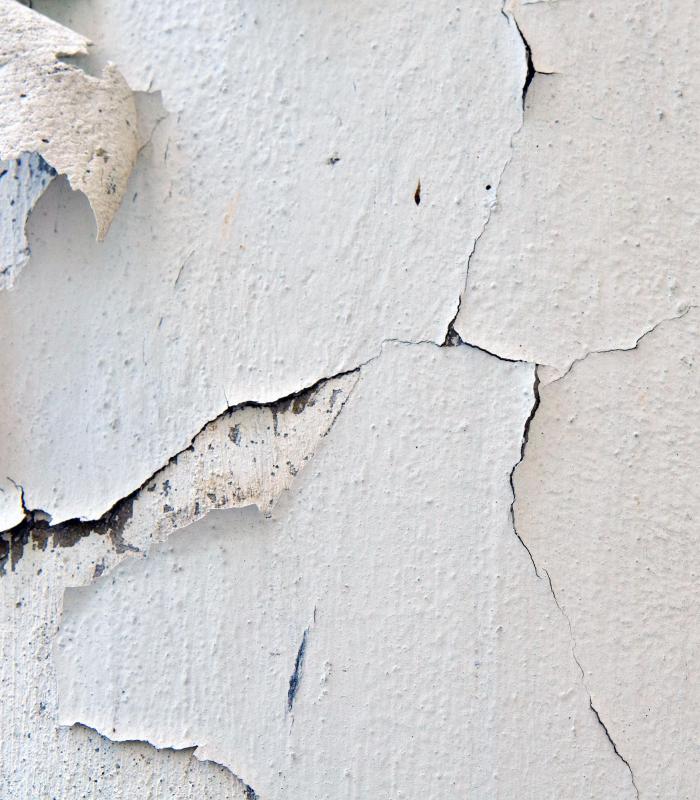At HomeQuestionsAnswered, we're committed to delivering accurate, trustworthy information. Our expert-authored content is rigorously fact-checked and sourced from credible authorities. Discover how we uphold the highest standards in providing you with reliable knowledge.
What Causes Ceiling Cracks?
Ceiling cracks happen naturally over time as a result of many factors. The older a structure is, the more likely that stress, moisture, and temperature will cause the formation of cracks. Several other factors, however, can accelerate effect of wear and tear. Poor workmanship is the most common cause of early cracks in a ceiling, specifically if inferior technique was involved in building the ceiling. Other external factors, such as accidents and forces of nature, can also lead to the formation of cracks.
All materials used in construction wear down over time. Plaster, wood, and other materials will crack under stress and pressure that's accumulated over time. This is especially true if the ceiling in question has another floor or attic above it. A large amount of force coming from the upper floor can be enough to cause ceiling cracks over the lower one. As a rule of thumb, the thicker the flooring, the sturdier the lower-floor ceiling is and the less likely it is for cracks to form.

Temperature and moisture fluctuations can also lead to ceiling cracks. Materials expand when moist or warm and contract when cool. If changes in either heat or temperature happen sporadically, as in monsoon seasons in tropical climates, this can lead to undue internal stress in the ceiling materials, causing a crack in the ceiling. In most cases, the crack is formed in the thinner layer of paint on the ceiling's surface, although cracks in the plaster itself are also possible.

Pressure, temperature and moisture can have a more significant effect if the ceiling was built with poor workmanship. For example, ceiling cracks are more likely to form if the builder neglected to put an additional layer of drywall compound in the areas where the wall meets the ceiling. Without the support for the additional compound, cracks can form out of poor adhesion. This is also true if low-quality building materials were used in construction. Providing an inadequate foundation for the building will also lead to ceiling cracks, as a lot of the internal weight will be supported by the walls and ceilings.

In extreme cases, ceiling cracks can form immediately. This most often happens when piping suddenly bursts and exerts a large amount of pressure on the ceiling or walls. Earthquakes of a great enough magnitude can also cause the building's weight to shift and form a crack in the ceiling. Any sudden powerful impact, such as a physical blow, can weaken the ceiling's structural integrity and cause it to crack.
AS FEATURED ON:
AS FEATURED ON:













Discussion Comments
My living room is huge. I had it painted with stucco. Over the years it has had small cracks. Today a big chunk of it fell. I believe the recent heat wave (that caused a five day power outage) was responsible. In any event, it appears the entire area is unstable and will fall. I am at a lost on what I should do. I am also afraid someone will get hurt if the remainder of it falls.
We live in an area with high humidity and extreme temperature changes year round. It is not unusual to have some cracks in the ceiling from this kind of weather.
No matter how diligent I am about painting over the cracks, it seems like they always come back sooner or later.
As far as I can tell we haven't had any structural or foundation damage. I have attributed these cracks to the changes in the weather and moisture from the humidity.
We have lived in our home for 15 years, and I noticed some small ceiling cracks in the bedroom and bathroom. Hoping that there was nothing seriously wrong with the foundation or something, I decided to fix it myself.
My ceiling is not textured, so this made the process a little easier. I watched some videos online to see what was the best way to go about repairing these ceiling cracks.
It just took a few supplies from the hardware store. I mixed up some mud, applied to the cracks and let it dry. Once it was dry I lightly sanded it down and then painted over it.
While it would have been easy to just paint the area where the cracks were, I took this opportunity to put a fresh coat of paint on the entire ceiling. This made the room seem much brighter and the cracks have not returned.
Post your comments